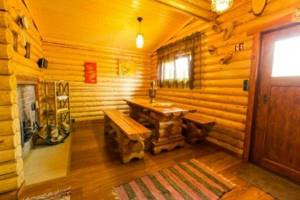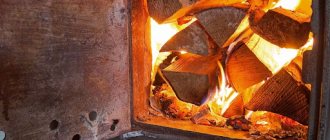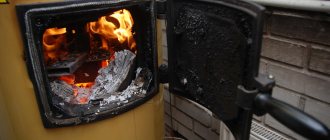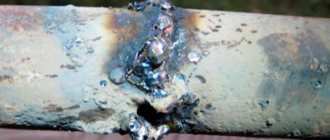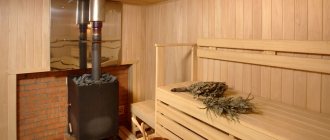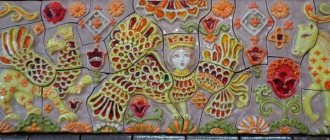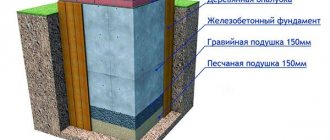Beginning bathhouse attendants usually do not understand very well how to heat a stove with wood in a bathhouse. Beginners rarely succeed in effective kindling right away - there are many nuances in this matter. Each stage - from harvesting or purchasing firewood to maintaining the required temperature in the steam room - requires a good theoretical basis. This article will help you achieve quick results.
Firewood harvesting rules
After choosing the optimal breed, you need to choose the right time to collect it. As practice shows, it is preferable to do this between February and March. The fact is that at this particular time of year the fibers are still frozen, so it will be quite easy to split the trunk. To determine that very moment, you can hit the wood with the back of an ax: when a ringing sound is heard, everything is perfect, but if a dull rumble echoes, the material has begun to rot from the inside.
Another important point to pay attention to is the number of branches. The more there are, the more difficult it will be to dry the wood.
Obviously, you won’t find a tree without knots in the forest, but you need to try to find options where there are the fewest of them.
If you have a good chainsaw, it is easier to purchase whole logs and cut them yourself later. This approach will save money.
If you buy firewood, you need to pay attention to the following features:
- Humidity of the purchased material. It should be no higher than 20%, then the firewood will ignite quickly and burn evenly.
- Uniformity. Make sure that the quantity supplied contains only the breed you have chosen, without other impurities.
If you prepared the material yourself in winter, it is better to dry it for about six months. After complete drying, it can be used in business. We’ll talk further about how to properly light a sauna.
Choosing firewood
Firewood and a stove are the pillars on which a good bathhouse stands. And, if an unusable stove can only be broken in order to be rebuilt, then unusable firewood can always be replaced. What kind of firewood should you avoid?
We don't need that kind of firewood.
“Yes, we don’t need this kind of hockey!” exclaimed legendary sports commentator Nikolai Ozerov, when Canadian professionals frantically began beating Soviet amateurs. Any self-respecting stoker has the right to say exactly the same phrase when he sees such firewood, before lighting the bathhouse:
- Railway sleepers. When dismantling and repairing railway tracks, a lot of free firewood often appears, which, greedy for free compatriots, happily drag to their native lands. Sleepers, poles and other elements of the industrial landscape are treated with protective compounds that prevent them from rotting. Burning them in a furnace leads to the sublimation of such substances and their combustion products into the internal atmosphere of the steam room, which is very fraught. Even deaths were recorded;
- Boards with traces of paintwork. The reason is the same;
- Wood with signs of destruction by fungi, the so-called rotten wood. In this case, you won’t be able to swallow chemical filth, but there will be little benefit from burning such raw materials. Wood that has been subjected to destruction by fungi and parasites greatly loses its caloric content and it is better to use suitable firewood than to heat the stove with dust, even if it is free.
What we look at with apprehension and distrust
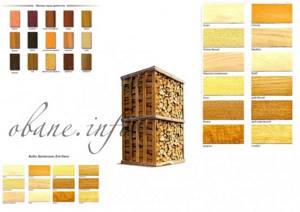
Due to a number of features, the following types of wood are not entirely suitable:
- Spruce is a low-calorie fuel. With an equal volume of burned raw materials, less heat is released. Due to the high resin content, a large amount of soot is released during combustion;
- Pine - gives a high, light, but low-temperature flame. They burn out quickly and do not retain heat well. Tendency to shoot coals, which requires increased attention to avoid fire in the furnace flue space. To a lesser extent, but also clogs chimneys with soot and tar deposits;
- Poplar and aspen are lightweight firewood that produces a long flame that burns well through chimneys, but is low in calories and does not retain heat well. When constantly used to fire a stove, conifer wood must be used to clean chimneys naturally, using the power of flame.
What we need
This includes firewood of the highest quality category. It is with these that it is most pleasant to decide how to properly flood a bathhouse:
- Alder is “royal” firewood. Produces a dense, clean, consistent flame. Fully high-calorie wood, quite acceptable in terms of labor costs for manual firewood harvesting;
- Oak and ash are very valuable woods that, when burned, give off a characteristic and unique spicy aroma. High-calorie firewood that retains heat perfectly. They burn long enough and evenly. Oak splits perfectly along the grain, producing dies of standard size. They are expensive due to the value of the wood. It is possible to use wood processing waste;
- Birch is probably the best option for solving the question of how to heat a bathhouse. They provide high-calorie and high-quality fuel raw materials. When using woodworking waste, birch bark should be used with caution, due to the increased release of volatile resins deposited on the walls of chimneys. With relative cheapness and accessibility, a true classic of the genre in the making;
- Fruit firewood - like any other hardwood, produces high-quality firewood, distinguished, among other things, by a subtle spicy aroma when burned. Quite expensive. In addition, some tree species are highly durable and knotty, which makes harvesting firewood in significant volumes quite a fun process in all respects.
How to heat the stove correctly?
1.Form the basis
Two logs are placed on the grate so that the distance between them is no more than 20 m. A sheet of paper is placed between the firewood, onto which wood chips are sprinkled. Two more logs are laid on top - the so-called “seed” or base is formed.
2. We begin to kindle
First, the paper at the base is set on fire, the flame should gradually transfer to the wood. You wait until the fire engulfs the wood, close the firebox door and cover the vent (leaving a small gap). If the firewood is moderately dry and of good quality, the “seed” will quickly flare up.
Note! Do not use incendiary mixtures or flammable substances to activate the flame. All this is a direct road to toxic smoke
In extreme cases, bathhouse attendants use dry alcohol tablets to light a bathhouse with raw wood.
3.Final ritual
In winter, the steam room is heated for about five hours, and in summer – up to four hours. When the bathhouse heats up to the required temperature, the fire can be stopped. You wait until the last of the wood burns out, make sure that the coals have smoldered, close the firebox, the vent and the smoke damper. Next, open the window in the steam room and the door so that there is a supply of oxygen in the room. Afterwards, close the doors and leave the window open (when the bath procedures begin, you can close it). Give approximately 40 – 60 minutes for the steam room to “infuse”. Don't be afraid that the heat will come out. On the contrary, there will be a softer atmosphere inside and the steam will be light.
|
| Give approximately 40 – 60 minutes for the steam room to “infuse”. |
What temperature should be in the steam room
After the firewood of the last stack has burned out and the surface has become grayish, when the coals move, the flames are red in color, without blue flashes (carbon dioxide has not yet completely escaped, if blue tongues appear), which means you can close the half-door and firebox, open the valves.
By this time, the stones should already be well heated and the water should boil (the temperature in the steam room should rise to +50-+60°C).
The next step is to ventilate the bathhouse. Open everything that can be opened, rinse the entire steam compartment and stones with boiling water. After ventilation, everything is closed, leaving only a window in the steam compartment. This allows you to heat the bath evenly in an hour and a half. Then close the window after this time. The steam room is ready and you can steam to your heart's content.
How to heat a sauna with wood
What can we say, a real bathhouse is heated with wood and only wood! Next we will look at other materials for kindling, but we will dwell in detail on firewood. The process of kindling is not much different for a metal stove. Before you learn how to properly light the stove, you need to prepare the room for bath procedures:
- We remove all foreign objects. We collect and take out everything that does not belong to the bathhouse.
- We begin cleaning the bathhouse and dressing room. First of all, we sweep all the debris from the floor, then it is advisable to wet clean the surfaces.
- I recommend that you periodically treat the steam room with an antiseptic to prevent damage to the wood.
- Ventilate the room thoroughly by opening all windows and doors.
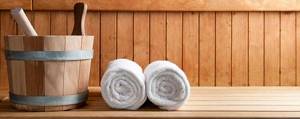
Preparing the bathhouse for procedures
Here are simple but important rules for preparing for bath procedures. Now let's get down to business.
Preparing the oven
First, let's start cleaning the oven. Everything here is quite simple - open the stove door, clean the ash pan and the fuel combustion chamber from ash and coal residues. Do not under any circumstances throw away this useful material; it can and should be used as fertilizer for your country rock garden.
The next step is preparing the firewood. Collect good, dry logs and stack them carefully away from the stove to prevent fire. We prepare dried bath brooms according to all the rules.
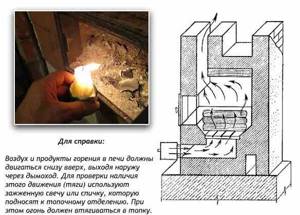
Checking the draft in the chimney
Important point. If the stove is designed with a water tank, be sure to check the presence of water in it. And don't forget to prepare bowls of cold water.
Now don’t forget to do the most important thing:
- Open the firebox door.
- Open the ash door.
- We open the damper between the stove and the pipe, commonly called a view.
- Control check! Light a match and lower the flame into the combustion chamber. Did the flame flutter and rush upward? So everything is in order, all doors are open.
There is no traction, but all the doors are open? This means that the stove nozzles or the stove pipe itself are clogged. In this case, the bathhouse cannot be heated, otherwise all the smoke will go not into the chimney, but into the dressing room! Be sure to check the “draft” of the stove; in my memory, more than once the pipe was clogged or they simply forgot to open the view. As a result, all the smoke went into the dressing room and a dangerous situation of carbon monoxide poisoning arose. Still, we don’t do a black bath; it has completely different features.
How to light a stove
Now let’s move on to the correct technology for heating a sauna stove. We made sure that all the doors are open and there is traction, let's start stacking the firewood.
First, let's make a small preparation, for it we will need:
- Tree bark or sawdust.
- Paper or newspaper crumpled into small balls.
- Four good logs, preferably approximately the same in shape and size.
We place the first two logs parallel to each other in the oven chamber, and they need to be laid behind the first holes in the ash pan. Between the logs we place lumps of paper and sawdust. We stack the remaining two logs on top of the first two in the manner of a well.

Example of workpiece laying
Carefully light the paper balls between the logs. If the firewood is damp, then it is better to use special alcohol candles that burn for a long time and do not go out.
Wait a couple of minutes and close the oven door. Keep the vent open!
Throwing firewood
Typically, firewood is consumed and burned within 15-30 minutes, it all depends on the firewood itself and the design of the stove. Open the door and level the coals over the surface of the oven. Fill the firebox with wood to about 2/3 of the height of the chamber, but do not place the wood too close to the stove door. For convenience, you can use a bath poker.
Update the bookmark as the wood burns out. On average, a Russian bathhouse takes 2-3 hours to heat, and in winter it takes twice as long, about 5-6 hours. Avoid burning the wood completely, otherwise the temperature in the sauna will drop and you will have to re-heat the sauna.

Load the oven to 2/3 of the chamber height
Do not burn any waste in the oven! You can not only ruin the smell of the room, but also get poisoned by the acrid smoke.
Getting ready for bath procedures
Open the door and carefully inspect the firewood. If they are properly burned, no open fire is visible, and the bathhouse has warmed up to 65 - 90 degrees (personally, I heat it up to 100 degrees), then you can open the pipe valve and close the vent. Ventilate the room thoroughly, then pour boiling water over the walls to increase humidity. The sauna is ready, enjoy your steam!
Preparing the premises
Before heating the bathhouse, it is necessary to prepare the room. Put the walls and shelves in order, wash them, ventilate the rooms. Fresh air and a clean environment will create the best conditions for health procedures. The stones from the steam room should be rinsed in clean water and put back in the same order.
The heating container must be rinsed thoroughly and filled with fresh water. The water in the tanks and pool is also renewed. In the dressing room, prepare clean towels, sheets, and other necessary accessories. Also take care of drinks in advance; these can be various herbal infusions, tea, kvass, or plain water. Drinking alcoholic beverages during procedures is strictly prohibited; this can have a detrimental effect on overall well-being.
Steam room preparation
Starting preparation consists of:
- removal of foreign objects;
- dry and wet cleaning of the premises;
- thoroughly ventilate the room - it is recommended to open doors and windows.
The sauna stove must be in correct condition. The comfort and safety of vacationers depends on how well the stove is prepared. A clogged chimney can allow carbon monoxide to enter the steam room.
Scheme for preparing the furnace:
- clean the ash pit and grate from coals and ash;
- wash the stones;
- check traction; to do this, open the ash and firebox doors and the smoke damper; after that, bring a lit match to the firebox - if the flame is drawn inward, the draft is working; an even flame indicates a clogged chimney, which in this case will definitely have to be cleaned.
If you have a boiler, check for water in it. Even if no one uses the water, without it the boiler will burst from the high temperature.
The preparatory work is done, the draft is in order - you can start lighting the stove.
Using a scoop, remove ash and unburnt coals from the stove into any suitable container. They can simply be thrown away or used as fertilizer for plants.
Next, the stones are prepared. If a closed heater is installed, then they must be rinsed to remove soot. If the open-type heater and steam room have already been used, then the stones need to be washed again. To do this, take warm water.
If the bathhouse does not have a full-fledged washing room with a shower, then the following steps should be taken: check the water tank (if installed) for the presence of a sufficient amount of water, prepare cool water for washing.
If the steam room is a separate room with a door, then it should be closed. Next, the doors and valves at the combustion chamber, blower and smoke view are fully opened. If there are two valves in the design of the smoke view, it is necessary to open the one through which fire and smoke directly exit into the pipe; the valve of the heating channel for the water tank and heater does not need to be opened.
The presence of draft is checked: a match or candle is lit and brought to the stove channel. The flame will certainly respond to the pull. If there is no reaction, then there is a high probability that the chimney is clogged. In this case, it is necessary to climb onto the roof and, using a special device, for example, a cleaning cable of the required length, remove the blockages.
It is necessary to prepare the following materials:
- Birch bark. It needs to be cut into thin pieces. To do this, you can use a sharp knife. Instead, you can take shavings or chop short chips.
- Newsprint.
- 4 logs. They should be dry and small in diameter (about the same thickness). The firewood must be of such a size that it can be easily inserted into the stove firebox.
Next is the “seed”:
- Two thin logs are placed parallel to each other on the grate. The distance between them should be equal to the width of your palm. The logs should be placed immediately behind the first vent holes from the ash pit.
- The paper is crumpled and placed between the logs.
- A little wood chips are poured on top of the paper.
- The two remaining logs are laid diagonally on top, leaving a small gap between them.
As a result, the paper and wood chips should end up in a well of logs. The resulting structure must be stable enough not to collapse due to careless actions.
How to prepare the stove for lighting
- Clean the ash chamber and firebox of the heater stove from ash and slag. Take all collected ash out of the bathhouse and make sure that there are no coals in the ash.
- Bring firewood into the bathhouse. For a bathhouse, it is better to choose firewood from hard wood: oak, ash, maple, birch. Coniferous firewood burns quickly and releases resin when burned.
- The heater must be doused with water to wash away dust and small debris that has settled on the masonry. Apply water to the boiler in advance.
- Check the chimney for draft. To do this, open the blower door and bring a lit splinter or match to the combustion chamber. If they burn well, then the draft is good. If they go out, then you need to look for the cause of poor traction. Often the cause may be nests that birds build at the end of the chimney or the accumulation of large amounts of soot on the internal walls of the chimney.
- The fire will flare up well if you use paper or birch bark and bark taken from birch logs to ignite. It is better not to use special liquids for rapid ignition, as they have a pungent odor that can spoil the air in the bathhouse.
- After the bark and birch bark burn well, you need to lay thin logs over them in a pyramid.
- You can light the stove in another way by laying two thin logs parallel to the grate. Place a mound of paper and bark between them. As soon as the flame is well lit, you need to place thin logs perpendicular to the previously laid logs.
- When starting a fire, fire safety rules must be followed. It’s good if there is a ceramic tile area in front of the stove. Then, the sparks falling from the furnace onto the floor will go out.
In order for the stove to heat up well and heat the bathhouse, you need to periodically stir the coals with a poker and lay a new portion of firewood on them. Firewood does not need to be pushed deep into the chamber. The stove should be filled two-thirds of the chamber with firewood.
How to light a stove
To light the stove you will need: four thin, even logs, birch bark, crumpled newspaper, wood chips, matches. First you need to build a mini-fire in the firebox of the sauna stove; it should not be located deep, above the first cracks of the vent.
To do this, you need to place two logs parallel to the grate, the distance between them should be no more than the palm of your hand. Place crumpled paper or birch bark between the logs and sprinkle a small pile of wood chips on top.
Place the remaining two logs diagonally on top of the resulting structure. The gap between them should not be too small, remember, fire loves air! This peculiar well of logs will become the beginning of the fire dance.
Now take matches and set fire to the paper, wait until it starts to burn, do not immediately close the firebox door, you just need to close it slightly. In a sauna pipe, due to pressure changes, there is often something like an air lock, so the fire does not have enough necessary draft from the pipe and the slightly open door supplies it with the necessary air.
After a few minutes, the bath pipe breaks through with fire and the draft intensifies; you can close the door more tightly and listen carefully to the characteristic humming, crackling sounds of the flame. If they calm down after a while, it means that the process of lighting the stove was unsuccessful and you need to start all over again...
If sounds from the stove persistently indicate that the fire dance is in full swing, you can safely close the blower door halfway. You cannot close it completely, otherwise your fire in the stove will go out; the fire needs access to air. You can also close the chimney damper halfway so as not to heat the street as well.
When everything in the firebox is blazing with fire, after about five to ten minutes you can add a new portion of firewood. To do this, open the oven door, arm yourself with a poker, level the burning logs and burn a new portion on them.
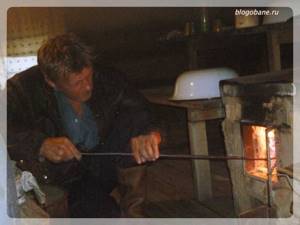
There should be space in the furnace firebox, that is, there is no need to cram the stove full of wood. But we need to learn to find a middle ground in how much firewood to put in.
There should be not a few of them, but not too many. Maintaining balance in this matter will only come with experience; do not despair if you fail to understand this science the first time. After all, as they say: “It’s not the gods who burn the pots”!
How to properly heat a sauna with wood?
Differences between an iron stove and a brick version:
- the metal counterpart warms up faster. For example, after twenty minutes from the moment of kindling, it reaches the optimal operating mode. The room warms up faster and better;
- the consumption of firewood in an iron stove is an order of magnitude greater than in its brick counterpart;
- a metal stove does not always maintain the same temperature in the chimney and firebox.
How to balance all the “poles” and “cons” of an iron stove? There is an option to use a shield made of bricks in a metal stove, or to build a brick chimney with a so-called “liner” made of stainless steel for a metal stove. There is also the option of covering a metal stove with bricks to increase the heat transfer time.
Instructions for lighting an iron stove:
- A small amount of paper is placed at the bottom of the firebox.
- Logs are laid out on the paper, but so that there is a small gap between them. When the firebox is about two-thirds full, leave some free space on top and set fire to the logs.
- When updating a batch of firewood, you still need to wait until the previous one burns out thoroughly.
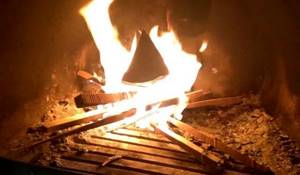
Common mistakes when lighting an iron stove:
- Too much wood in the stove;
- The logs lie tightly in relation to each other - this is the first cause of smoke. Gases must circulate freely in the stove;
- The stove vent closes too early, which also leads to disruption of the gas circulation process.
- Powerful draft and too much fire do not mean that the stove is burning correctly. With the right approach, you can achieve good heat by slowly burning a small amount of logs.
To compare the quality of steam in a bathhouse with brick and metal stoves, as well as a black bathhouse, select the appropriate option in the catalog of steam rooms in St. Petersburg, where all bathhouse establishments in the city are presented.
It is not recommended to heat the steam room too much for the first time. It is better to heat it little by little over several times so that the stove dries out and “adapts” to work. The next five times should be done “increasingly.”
|
| The steam room should warm up to a level of 50 - 60 degrees and about 60% humidity. |
How to efficiently heat a relaxation room in a bathhouse in winter?
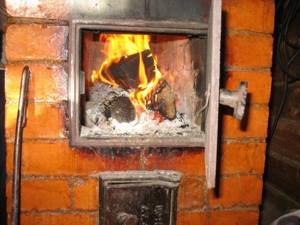
Option No. 2 – gas convector. Relatively easy to install, fits organically into the bath design.
Option No. 3 – an exclusive stove with a glass door similar to a fireplace. It costs more, but it looks stylish. Even when the stove in the steam room cools down, the relaxation room will be warm and cozy.
|
| In the case of a new stove, “running in” the structure is important, and sudden kindling is not necessary. |
Useful recommendations for high-quality kindling of a sauna stove
- At the very beginning, open the blower to the maximum - for a more effective flow of fresh air;
- Use firewood wisely. After about 5 - 8 kindlings you will understand how much wood is needed. In the future, simply cook this volume to avoid overheating.
- To control temperature and humidity in the steam room there must be a thermometer and a hygrometer. Update them regularly.
- If you have not heated the steam room for a long time, it will take a little longer to warm it up. With regular heating, it takes about a third less time to warm up the steam room.
How to light a stove with raw logs?
Kindling stages:
- Chop the raw logs into slivers.
- Place them together to form a cone.
- Place crumpled paper or shredded bark inside.
- Open the furnace vent to maximum.
- Light a torch and use it to light paper or bark.
- Open the blower door to maximum.
The stove needs to be melted with wood chips for 15 minutes. After this you can add small sticks. Logs are added when there are enough coals and the walls of the oven are warmed up. To speed up the kindling, it is recommended to use a liquid ignition composition.
To ensure that moisture leaves the wood faster, raw logs must first be sprinkled with salt. Wait 10–15 minutes, clean off the salt. After this, you can start lighting the stove.
If wood is stored outdoors, logs or hemp should be laid out in rows so that adjacent rows do not touch each other. They should be located under a canopy. The edges can be covered with thick plastic film to protect from slanting rain.
Algorithm for lighting a sauna stove
There are four stages of lighting a bath; consider each of them in detail.
Preparing the oven
The stove and bathhouse need to be prepared. You need to put things in order in the bathhouse - remove leaves, wood chips, and any debris. The stove must be cleared of ash. For this you need a poker and a scoop.
Check the cleanliness of the heater. Rinse the stones themselves with water. Bring dry firewood to the bathhouse. Place them at a distance from the stove to prevent stray sparks from flying.
Next, determine the presence of traction. It is necessary for the release of carbon monoxide. It is necessary to open the firebox door, the vent and the smoke damper of the chimney. Light a match and bring it into the firebox. The flame goes up - that means everything is in order. If it doesn’t work, you’ll have to clean the chimney. Without cleaning, you can get burned in such a bath. The chimney can be cleaned with a wire brush or brush. Carefully sweep away all the soot and check the traction again.
Some owners know how to check traction without a match, simply by a breath of air.
Kindling process
Kindling is ignition with dry wood chips. Or small, well-dried firewood. The chimney needs to be opened, the ash pan also opens 6 centimeters. For better ignition, you can use paper and a torch. Crumpled paper and wood chips are laid out and set on fire without special liquids.
Loading firewood
After the wood chips have burned out, you can load firewood into the stove. Firewood should not fill the firebox to the ceiling. You need to leave about 25% free space. Freely circulating air will help the wood burn better. First you need to place the paper on the coals and lay dry firewood on top, leaving a gap between them. Paper will make firewood faster. Firewood should be stacked closer to the door so that all the heat does not go into the chimney.
In order for a brick oven to fire correctly, it must be periodically topped up with firewood. How often to do this depends on the moisture content of the firewood, its size and the draft force in the stove. You can increase the burning rate by pushing the ash pan almost all the way in and opening the chimney halfway. The stones will heat up faster. You must remember to heat the water if there is no special tank on the stove.
If the chimney pipe is very hot, you need to open the chimney wider and do not add firewood yet.
On average, you can heat a sauna with wood in 3–4 hours. In winter the process will be slower. Before finishing the kindling, you need to check for carbon monoxide residues. To do this, stir the coals. If blue-green flames are noticed, gas still remains and heating must be continued.
It is necessary to properly heat a brick oven to the maximum, that is, load it completely, and not in small portions. It is necessary to add firewood if the bathhouse is not heated.
Final stage
At the end of the kindling process, the damper, vent and firebox must be closed. The bathhouse is ventilated for about 15 minutes, then boiling water is poured over the walls to create steam. Impatient lovers can take the procedures immediately, but it is recommended to leave the bath for 1-2 hours. At first the steam will be hot, the lightest steam is obtained at the end of your stay in the steam room. All the wood will burn out at that point, leaving only smoldering coals.
After completing the bath procedures, the room must be dried. Forced ventilation is rarely installed in private baths. In order to dry the steam room, open the window, the door and throw several logs into the firebox. The stove becomes a ventilation element. Excess moisture disappears in a couple of hours when doors and windows are open.
Cleanliness is the key to a healthy microclimate!
First, regardless of the stove you choose for the bath, you need to clean up the room where it is located. Actually, after each procedure, the floors are washed and the remaining leaves are swept away. You need to clean up especially carefully around the stove itself. Immediately before the procedures, the room is ventilated for half an hour.
Any stove in a bathhouse is an individual mechanism. Even despite the external similarity and the same functionality. This is characterized by the fact that each stove maker approaches work in his own way. According to this, almost all of them are heated differently, but the principle of operation is the same.
There are certain rules for kindling, compliance with which will allow you to avoid unpleasant situations, such as:
- carbon monoxide poisoning;
- getting heatstroke;
- possibility of fire.
Preparatory stage
Before starting the bath ritual of lighting the stove, let's prepare it for this. Using a special scoop, empty the ash chamber (in common parlance - the ash pan), as well as the grate part. Remains of combustion products are removed from the premises. Then we prepare firewood (preferably birch) and store it at a safe distance from the stove.
Examine the heater. If it is open, rinse with water. But only if this was not done before during 5-6 bath rinses. We check the water supply in the boiler and, if necessary, replenish the missing part.
It is imperative to determine the presence of traction. We completely open the ash pan, the combustion door and the damper on the chimney. We light a match and bring it to the door. Everyone knows how to determine the presence of traction from school lessons and personal experience in lighting street fires. If everything is in order, we proceed to the following procedures. If there is no draft, you need to check the chimney. The reason for the absence may be clogging of the pipe with ash, bird nests (and they love to huddle in such places) or a malfunction of the deflector on the chimney .
Detailed instructions for heating an iron stove in a bathhouse
Adding fuel to the stove
Properly heating a sauna with wood and an iron stove is very simple. There is a special algorithm:
- Place 5-7 crumpled newspaper sheets on the bottom of the firebox, cleared of ash. There is no need to crumple the paper tightly; you should leave small layers of air between the natural folds.
- We begin to lay out small firewood (chips) on newspapers so as to cover the entire surface of the stove bottom. Between the logs of the bottom row you need to leave small gaps, about the width of a finger - this way, during kindling, air from the ash pit will flow more efficiently into the stove.
- We continue to lay the logs one on top of the other, placing birch chips slightly protruding forward between them. Any dry wood chips will do, but birch wood is easiest to light. Stop filling when the firebox is about 80% full to leave room for gas circulation. Now you can set fire to the wood.
- When adding firewood during the fire, you need to wait until the previous batch burns down to the state of bright red coals, and only then lay the next batch of logs.
The oven is lit, you can use it
Using the gate
A damper is a damper on a stove chimney. Its task is to prevent heat from leaving the room through the chimney when the combustion process is already completed.

How to use the gate correctly? The only important rule when using a damper is to close the chimney only when the combustion has already completed. Otherwise, even if there is no fire in the stove, but only active smoldering, there is a risk of carbon monoxide leakage
Adviсe
- You can hang a thermometer and a hygrometer in the steam room - this will allow you to control the atmosphere in the bathhouse even before it completely melts and understand when you need to stop adding firewood to the stove.
- You can, by trial and error, calculate how many logs are needed to create a comfortable atmosphere in the bathhouse, and at all subsequent times simply prepare the required number in advance to avoid overheating.
- Bath brooms can be prepared in the summer and used throughout the season if stored correctly. The ideal condition for a broom during storage is hanging with the spine down.
- At the beginning of the kindling, the vent should be open as much as possible for a better flow of oxygen.
Common mistakes
- Too much firewood at once. If the firewood in the stove, especially one that has not yet been lit, is placed too tightly, there is a risk of smoke in the room, because there will be no normal circulation of gases in the firebox of the stove.
- Blower/gate valve closed too early. In both cases, violation of the order of using the stove leads to difficulty in the circulation of gases during the combustion process.
How to wash soot in a bath
After each bath procedure, it is necessary to clean the room from the soot layer. The use of the following products is not recommended:
- water;
- liquid or laundry soap;
- sponges;
- hard brushes;
- spray bottle.
These products can be used when the surface is completely free of soot.
It is mandatory to use personal protective equipment:
- robe;
- rubber gloves;
- headdress;
- glasses;
- gauze bandage or respirator.
There are two ways to clean a bathhouse from soot: with mechanical devices and cleaning with chemical compounds.
Mechanical devices. You can use a spatula or a sharp scraper. This type of cleaning will require a lot of time and effort. To make your work easier, experts recommend a grinding machine. Then remove the resulting dust with a clean cloth and soapy water.
Cleaning with chemical compounds. The easiest way, according to the instructions, is to use liquid chemical compounds. Simply spray the product onto the contaminated surface and wash off after a while. Such preparations contain alkali components that quickly remove soot from a wooden surface.
Important! Do not use abrasive cleaning products for cleaning. You can use a chemical sponge
It is impregnated with special substances that quickly and safely remove soot and soot from wood
You can use a chemical sponge. It is impregnated with special substances that quickly and safely remove soot and soot from wood.

After all cleaning work, rinse the surface with clean water and wipe dry.
How to heat a black sauna
What does it mean to heat a bathhouse black? Firewood is placed in the hearth and then lit. The process itself is not very pleasant and simple. You need to add logs quickly to avoid inhaling carbon monoxide. When entering, bend low, as the smoke spreads along the top, and you are less likely to swallow it.
When heating a black bathhouse, you need to be extremely careful. There is a high probability of fire, so have a container of water ready to eliminate unwanted consequences as quickly as possible.
It is important
Do not leave the sauna unattended while it is heating. Monitor the entire process carefully. To throw firewood into the steam room, go into the steam room crouching down so as not to inhale carbon monoxide.
Choose hardwood wood for heating - birch, linden, alder or oak. When burned, they release useful resins and tar, which disinfect the steam room. Do not use firewood from coniferous trees - pine or spruce. When burning, they will crack a lot, and the spruce can throw embers some distance away, which increases the possibility of a fire.
The combustion process takes on average from 2 to 4 hours. After the stove stones have become hot, the temperature in the Russian bathhouse is considered suitable for bathing. All remnants of coals and ash are removed from the fireplace, the stove is “sprinkled” with water and left with the door ajar for another hour and a half, for the carbon monoxide to completely evaporate.
After the first swimmer has entered and tightly closed the door behind him, the high but comfortable temperature in the steam room remains for several hours.
During combustion, soot usually covers the ceiling and walls. However, before you start bathing, it is recommended to wash the benches and shelves with water to remove any soot, if any.
Recommendations for heating a sauna
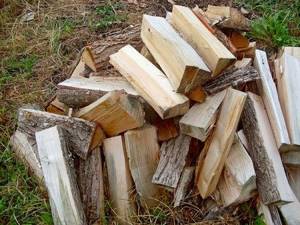
Increased humidity in wood impairs combustion, so they must be dried beforehand. It is necessary to stack firewood with gaps and in such a way that there is at least 200 mm left to the top of the firebox. It is advisable to heat the bathhouse with dry birch wood, which produces less soot, or aspen, pine, oak, spruce, etc.
You cannot throw painted wood, plastic, roofing felt, or bitumen into the firebox. Do not overheat the stove: cracks will appear in the lining and masonry. When there is no bluish-blue flame above the remaining coals in the firebox (a consequence of the combustion of poisonous carbon monoxide, the so-called carbon monoxide), the firebox is considered complete. After 5-10 minutes, you can tightly close all doors and dampers.
To avoid carbon monoxide poisoning, do not light the stove late in the evening. If the design provides for the stove to operate on coal or anthracite, the valve should be installed in such a way that it does not close tightly and leaves a gap of at least 10-15 mm.
First, light the stove with small wood. A 50-60 mm layer of coal is poured onto them. After the coal burns well, the backfill thickness is adjusted to 150 mm, but no more, otherwise fuel consumption will be uneconomical. After the fire is completed, the remaining coals are raked onto the grate so that they are well blown with air coming from the ash pit.
If there is no grate, rake it closer to the outlet of the oven. If there is excessive gas formation in the firebox, a flame may erupt. This usually happens when they try to light the stove with flammable liquids (gasoline, kerosene, etc.). If the concentration of gases is high, an explosion may occur, which can not only destroy the furnace, but also cause a fire.
The firebox cannot be loaded with a new portion of fuel (especially fine-grained fuel), completely covering the hot surface of the furnace bottom: it “languishes,” releasing a large amount of volatile substances, without flaring up due to the lack of flame and a decrease in temperature. In this case, the concentration of gases increases sharply and at the first appearance of a flame an explosion occurs.
Therefore, fine fuel must be loaded into the furnace in small portions, giving it the opportunity to flare up gradually
The fire door must be opened carefully so as not to cause a sudden fire.
Characteristics of firewood
It is not always appropriate to compare heating a house with a stove and electricity or gas, since the stove additionally creates an atmosphere of comfort and unique family coziness. How pleasant it is to hear the soft crackling of firewood in the hearth in the silence of the doom, to feel the warmth emanating from it. Even in our time, these unique feelings are so pleasant to people that a high-quality stove or a good fireplace is built in almost every private home.
However, in order to effectively use the capabilities of the stove, you should understand firewood. It turns out that not all tree species are equally good for burning; there are many nuances that significantly complicate the choice of firewood for the stove.
For example, for burning in a fireplace, it is advisable to find wood that, when burned, emits a pleasant aroma, but does not emit a large amount of resin, soot, or soot. Resins in wood contribute to increased smoke output, as well as explosive cracking of logs with the release of large coals. Such emissions will be unsafe for an open fireplace, so coniferous wood is not used in them.
Firewood for the stove is selected based on heat transfer; its main criteria are the intensity and duration of combustion. It is desirable that the wood burns with less smoke and leaves behind a minimum of ash.
If we consider the optimal firewood for use in a stove, then it should have the following functionality:
- First of all, heat transfer is the maximum possible for wood.
- The flammability of the wood must also be excellent, so that lighting a fireplace is not difficult.
- When burned, firewood should not emit a lot of smoke and leave behind a small amount of ash.
To achieve such characteristics, it is important not only to choose the right type of wood, but also to properly dry the harvested timber and ensure its normal storage. Freshly cut wood is not used in ovens; to prepare it, it should be dried for some time, getting rid of excess moisture
Wet wood burns weakly and produces a large amount of smoke.
There is even a method for determining whether firewood is dry enough for use in fireplaces or stoves. You should hit one log against another and listen to the sound. If it is sonorous, then it is quite possible to use such logs for heating the hearth.
It is believed that the best firewood for fireplaces and stoves is obtained if logging is carried out in the winter. At this time, the trees are in a certain preserved state, as a result of which sap flow practically does not work in them. The worst thing is if the firewood is collected in the spring or summer, when the wood contains a large amount of moisture, such wood will dry out for a very long time.
If we consider tree species, then it is best to choose deciduous options, since they have a fairly dense fiber structure. Such wood is capable of generating large amounts of heat for a long time. Most often, firewood is prepared from the following hardwoods: oak, birch, linden, alder, ash, aspen. Even fruit trees can be a good source of heat. In addition, the fragrant wood is perfect for use in a smokehouse or open fireplace.
Coniferous wood also burns well, but since they contain a large amount of resin, they emit a lot of smoke and soot when burning. The needles burn quite quickly, but produce mediocre heat, so for use in a stove at home it is better not to particularly consider this option, but to save the logs for the bath.
Important component #1 - good firewood
The choice of firewood determines how quickly your sauna will be heated and how hot the sauna will be. Preference should be given to hardwood: hornbeam, oak, ash, maple. These rocks have the highest heat transfer, that is, they release the greatest amount of heat during combustion. The calorific value of wood from fruit trees (apple, pear, cherry) is somewhat lower, but it also provides good heat in the oven. The calorific value of deciduous trees is even lower: birch, alder, etc. Despite this, deciduous trees are used most often due to their availability and low cost. Coniferous firewood is the least popular choice for heating a sauna stove. This wood produces little heat; in addition, when burned, it produces a lot of soot, which settles in the chimney and on stones.
Another important characteristic of firewood that is also worth paying attention to is humidity. The smaller it is, the better the sauna will be heated. Ideally, the moisture content of the firewood does not exceed 20%. Freshly cut wood has a moisture content of 33 to 50%, so it burns poorly. To dry such firewood, it is enough to let it sit for some time in a dry, well-ventilated room.
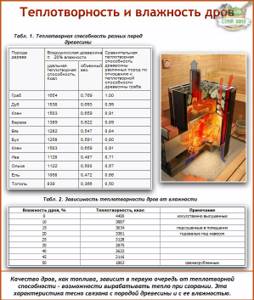
Now let’s figure out what kind of wood it is better not to heat the bathhouse with. Not suitable for this:
- old boards and logs - due to the unpleasant smell when burning.
- Rotten firewood burns poorly and produces a lot of ash.
- Wood impregnated with chemical compounds releases substances hazardous to health during combustion.
Summing up
In this article, we talked in detail about how to light a sauna and what kind of wood is best to heat it with, and looked at all the features of this process. Now all you have to do is prepare a sufficient amount of material and properly prepare the heating device for operation. If you have any additional questions, you can always ask the specialists at the time of purchasing the stove. They will explain to you in detail all the intricacies of the device of a particular model and tell you how to make the product last as long as possible. Modern metal structures are made with high quality; it is enough to follow basic rules such as timely cleaning of the firebox from ash, regular inspection of the chimney and compliance with operating techniques.
Please note that this article is for informational purposes only and under no circumstances is it a public offer as defined by the provisions of Article 437 (2) of the Civil Code of the Russian Federation
Read with this
- Pompeii oven
- Even more opportunities for relaxation! building a Russian stove on the street with your own hands: diagram and instructions
- How to weld a sauna stove from a pipe or cylinder
- Do-it-yourself stove for a cauldron: instructions for making a brick and metal stove
- An example of the arrangement of a heating stove
- Making the simplest stove with your own hands (10 photos)
- How to properly install a heater stove in a bathhouse and sauna
- Dutch oven made of brick
- Why does the stove smoke and how to fix it yourself?
- Do-it-yourself Buleryan stove: we make a Buleryan stove by studying the drawing and manufacturing and assembly diagram
Nuances of lighting a bath with a metal stove
You can properly heat a bathhouse with a metal stove if you know the necessary details of its design.
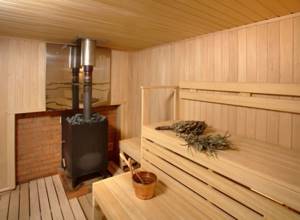
At the beginning of lighting a metal sauna stove, you need to create good draft
Metal bath stoves are made direct-flow. Carbon monoxide and smoke go directly into the chimney. In brick stoves, the smoke circulation is not direct; the pipe has a complex winding structure. Therefore, it is easier to light the stove and the wood will burn long and evenly.
If the metal stove is purchased, it is equipped with plates - dividers, which create a semblance of smoke circulation. It is absent in hand-made ovens. The presence of smoke circulation has the effect of selecting additional heat from the gas entering the pipe.
Metal sauna stoves have a short chimney, which gives insufficient draft. It is recommended that the chimney length be more than 3 meters. With sufficient draft, firewood burns well and gives a high heat transfer coefficient. You can regulate the draft using a damper on the chimney pipe and a blower. The wider they are open, the better the traction will be.
At the beginning of the kindling, you need to create a good draft so that the chimney warms up faster. If it does not heat well, part of the smoke goes into the steam room. To speed up the heating of the chimney of a metal stove, you must first burn easily burning products - wood chips and paper. Only then put firewood in it.
When the stove flares up, the vent must be closed completely or left a gap. The draft can be monitored by the color of the flame. Normally it should be yellow. If the flame is reddish, you need to increase the draft. If there is an excess of draft, the flame will be whitish, the wood will burn out quickly, and the chimney will overheat. Therefore, the vent must be closed. If this does not help, also cover the gate, if available. Both the vent and the damper cannot be closed tightly so that smoke does not go into the bathhouse.
The peculiarity of a metal sauna stove is also that it needs to be constantly heated. Brick stoves are heated until the bath is completely heated, and then fuel is added if necessary. And in this case, there will be no constant heating temperature and you need to put the logs in again. In order to slow down the burning process, you need to put larger firewood. The difference lies in the need to open the gate after the main firing. It is not closed in a metal oven.
The chimney of a metal sauna stove must be cleaned regularly to avoid its destruction and fire. Soot accumulates in a narrow space and can catch fire.
Preparation and storage of firewood
Harvesting firewood in the forest is only possible with special permission. You can order ready-made, chopped logs.
Rules for storing solid fuel:
- The logs should not lie too close to each other. There should be air circulation so that they dry faster.
- You cannot store firewood on the ground. It is better to prepare a separate place outside for storing logs.
- It is difficult to build a separate firewood shed, but in it the firewood will be protected from precipitation and will dry faster.
You can buy a metal firewood rack.
Knowing how to light a wood-fired sauna and maintain the flame, you can safely begin sauna procedures. It is recommended to prepare fuel in advance so that the logs have time to dry before use.
At the same time, it is important to choose a fuel that will produce maximum heat and emit a pleasant aroma.


